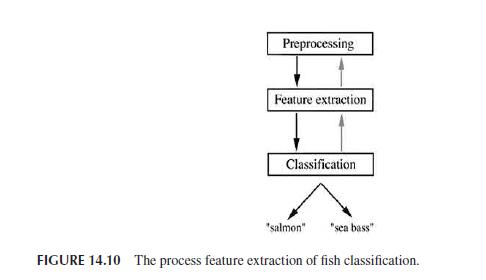Suppose that a fish packing plant wants to automate the process of sorting incoming fish. We set
Question:
Suppose that a fish packing plant wants to automate the process of sorting incoming fish. We set up a camera, take some sample images, and begin to note some physical differences between the two types of fish and suggest features to explore for use in our classifier. We also notice noise or variations in the images such as variations in lighting, position of the fish on the conveyor, even
“static” due to the electronics of the camera itself. Given that there truly are differences between the population of sea bass and that model of salmon, we view them as having different models.
The process of feature extraction of fish classification is shown in Figure 14.10 The overarching goal and approach in pattern classification are to hypothesize the class of these models, process the sensed data to eliminate noise (not due to the models), and for any sensed pattern choose the model that corresponds best.
The objects to be classified are first sensed by a transducer (camera), whose signals are preprocessed, then the features extracted and finally the classification emitted (here either “salmon” or
“sea bass”). Although the information flow is often chosen to be from the source to the classifier
(“bottom-up”), some systems employ “top-down” flow as well, in which earlier levels of processing can be altered based on the tentative or preliminary response in later levels (gray arrows). Yet others combine two or more stages into a unified step, such as simultaneous segmentation and feature extraction.
Suppose somebody at the fish plant tells us that a sea bass is generally longer than a salmon.
These, then, give us our tentative models for the fish, namely, sea bass have some typical length
(l*), and this is greater than that for salmon. Then length becomes an obvious feature. Suppose that we take samples and obtain the histograms (Figure 14.11 ).


Step by Step Answer:

Water Systems Analysis Design, And Planning Urban Infrastructure
ISBN: 9780367528454
1st Edition
Authors: Mohammad Karamouz





